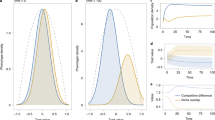Abstract
Niche construction is a process whereby organisms, through their metabolism, activities, and choices, modify their own and/or each other’s niches. Our purpose is to clarify the interactions between evolution and niche construction by focusing on non-linear interactions between genetic and environmental factors shared by interacting species. We constructed a new fitness landscape model termed the NKES model by introducing environmental factors and their interactions with genetic factors into Kauffman’s NKCS model. The evolutionary experiments were conducted using hill-climbing and niche-constructing processes on this landscape. The results have shown that the average fitness among species strongly depends on the ruggedness of the fitness landscape (K) and the degree of the effect of niche construction on genetic factors (E). Especially, we observed two different roles of niche construction: moderate perturbations on hill-climbing processes on the rugged landscapes, and the strong constraint which yields the convergence to a stable state. Also, we show that the difference in the structures of (direct or indirect) interactions among species drastically changes the coevolutionary process of the whole ecosystem by comparing the evolutionary dynamics of the NKES model with that of the NKCS model.











Similar content being viewed by others
Notes
In this paper, the term niche refers to evolutionary niche defined by Odling-Smee et al., that means the sum of all the natural selection pressures to which the population is exposed [2].
References
Odling-Smee FJ (1988) Niche constructing phenotypes. In: Plotkin HC (ed) The role of behavior in evolution, MIT Press, Cambridge, pp 73–132
Odling-Smee FJ, Laland KN, Feldman MW (2003) Niche construction—the neglected process in evolution. Princeton University Press, Princeton
Laland KN, Odling-Smee FJ, Feldman MW (1996) Evolutionary consequences of niche construction: a theoretical investigation using two-locus theory. J Evol Biol 9:293–316
Ihara Y, Feldman MW (2004) Cultural niche construction and the evolution of small family size. Theor Popul Biol 65:105–111
Silver M, Di Paolo E (2006) Spatial effects favour the evolution of niche construction. Theor Popul Biol 70:387–400
Taylor T (2004) Niche construction and the evolution of complexity. In: Proceedings of the ninth international conference on the simulation and synthesis of living systems (ALIFE IX), Boston, pp 375–380
Suzuki R, Arita T (2006) How spatial locality can affect the evolution of niche construction. In: Proceedings of the tenth international conference on the simulation and synthesis of living systems (ALIFE X), Bloomington, pp 452–458
Suzuki R, Arita T (2010) Effects of temporal locality of ecological processes on coevolution of learning and niche construction. In: Proceedings of the twelfth international conference on the simulation and synthesis of living systems (ALIFE XII), Odense, pp 471–477
Yamauchi H, Hashimoto T (2010) Relaxation of selection, niche construction, and the Baldwin effect in language evolution. Artif Life 16(4):271–287
Bown O, McCormack J, Kowaliw T (2011) Ecosystemic methods for creative domains: niche construction and boundary formation. In: Proceedings of the 2011 IEEE symposium on artificial life, Paris, pp 132–139
Hui C, Li Z, Yue D (2004) Metapopulation dynamics and distribution, and environmental heterogeneity induced by niche construction. Ecol Model 177:107–118
Harvey I (2004) Homeostasis and rein control: from daisyworld to active perception. In: Proceedings of the ninth international conference on the simulation and synthesis of living systems (ALIFE IX), USA, pp 309–314
Williams H, Noble J (2005) Evolution and the regulation of environmental variables. In: Proceedings of the eighth European conference on artificial life (ECAL 2005), Canterbury, pp 332–341
Dyke JG, Weaver IS (2013) The emergence of environmental homeostasis in complex ecosystems. PLoS Comput Biol. 9(5):1003050
Lenton TM (1998) Gaia and natural selection. Nature 394:439–447
Suzuki R, Arita T (2005) Evolution and niche construction in NKES fitness landscape. In: Proceedings of the tenth international symposium on artificial life and robotics, Oita, pp 493–496
Suzuki R, Arita T (2005) How niche construction can guide coevolution. In: Proceedings of the eighth European conference on artificial life (ECAL 2005), Canterbury, pp 373–382
Kauffman S (1993) The origins of order: self-organization and selection in evolution. Oxford University Press, USA
Author information
Authors and Affiliations
Corresponding author
About this article
Cite this article
Suzuki, R., Arita, T. Coevolution of multiple species through niche construction modifying shared environments. Artif Life Robotics 18, 144–151 (2013). https://doi.org/10.1007/s10015-013-0116-y
Received:
Accepted:
Published:
Issue Date:
DOI: https://doi.org/10.1007/s10015-013-0116-y



